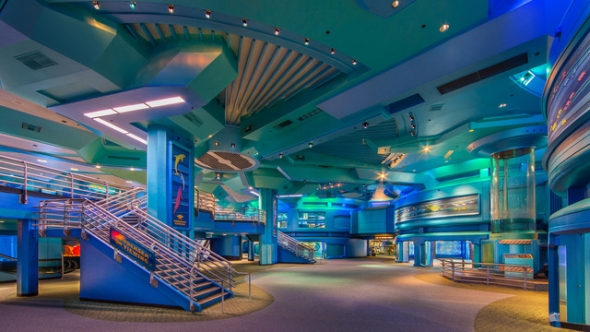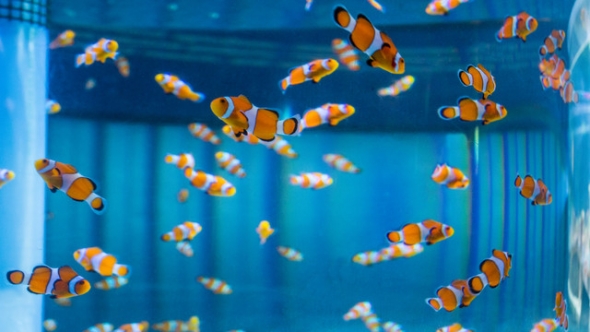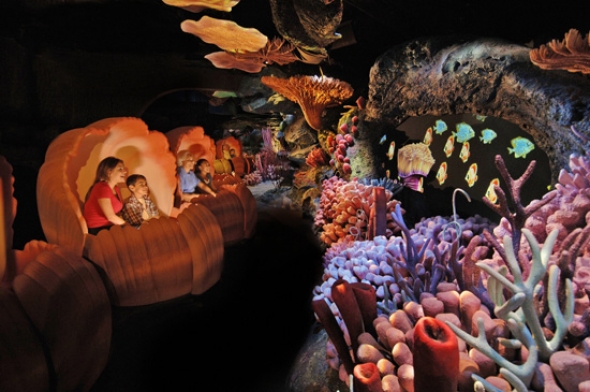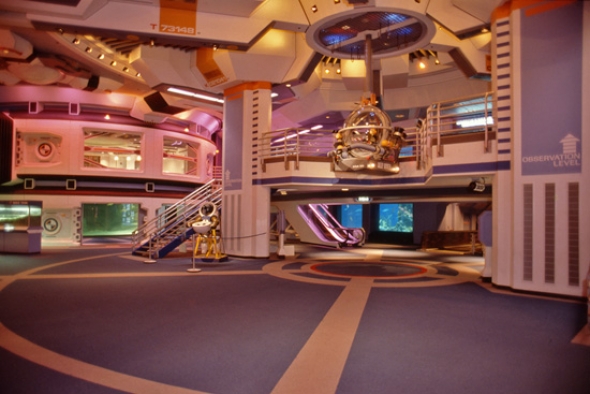Killer dolphin: NOT a SyFy movie
The problem dolphin was named Bob. He was part of a school of dolphins along with Christie and Katie, the females, and males named Geno, Toby, and Tyke. Over a period of three years, Bob killed three of his siblings. A fourth died of non-Bob-related causes, leaving only the killer dolphin and what I’m confident was a very nervous sibling who never turned his blowhole on Bob.
I want to stress that the problems were not Bob’s fault. If you take any mammal out of its natural environment, you shouldn’t experience surprise if the creature lashes out. In Bob’s case, he became two aggressive with his fellow dolphins. That behavior directly caused two deaths in 1987, and then he “roughhoused 12-year-old Katie, worsening her lung condition and leading to her death, preliminary test results show.”
Animal rights activists were understandably appalled. Disney adapted a transparent posture, with a corporate vice-president acknowledging that The Living Seas had a “pretty cruddy” record with dolphins. Since Bob killed both the females, Disney’s dream of breeding the dolphins died with Bob’s multiple sororicides. They later transferred him to the National Aquarium in Baltimore, where he promptly contributed to the deaths of two other dolphins before dying himself.
Disney had the legal right to try to breed dolphins again. So, they acquired a trio of them from the Navy. Another government agency had marked them for release. Disney stepped into a bureaucratic nightmare, and their attempt failed yet again. The dolphins currently hosted at The Living Seas were all acquired elsewhere. Nobody questions the treatment of these mammals, but the potential for negative publicity always exists as long as Disney continues to host them. They largely avoided the backlash that destroyed SeaWorld during the Blackfish fiasco since they don’t host creatures of that size. Also, consumers natural trust Disney more as a brand. The benefit of the doubt has helped them remain above the fray.
“For a guy with three hearts, you are not very nice.”
On a lighter note, dolphin caretaking isn’t the only problem Disney faced in populating their aquarium. Their original announcement for The Living Seas celebrated the presence of sea lions. Quick, when’s the last time you saw a sea lion there? Sure, they’re a staple at SeaWorld, but they're persona non grata at Epcot. The reason for that is simple. They stink.
In the early days of The Living Seas, cast members quickly came to resent the presence of the sea lions. They seem so harmless and fun from a distance. Up close, they’re loud, obnoxious, and odiferous. Over the years, Disney quietly phased out the sea lions part of the habitat, repurposing it as a home for manatees.
Today, the location hosts Lil Joe, widely considered the most famous manatee in aquatic history. For 25 years now, he’s enjoyed his celebrity status at several zoos and theme parks. Disney hosts him at the pavilion to save the manatee from getting stuck in the pipes again.
Yes, Disney would rather have a clumsy, fat manatee who is terrible with directions instead of sea lions. That says everything about how awful they were as residents of The Living Seas. Finding Dory’s sea lions have a presence in the movie due to the popularity of fish tales involving the terrible behavior of these creatures. It’s an open secret at Epcot that they quickly wore out their welcome. Take a moment to consider how awful they must have been. Even Bob received the benefit of the doubt for several years and a few murders!
If you’re interested in learning more about the complexities of the dolphin capture issue, you can read more about Sweeney here and a Time article about the practice here. And this PBS piece reveals why the Navy employs dolphins.
In the big blue world
Image: Disney
As attendance dwindled as the underwater pavilion, cynics derided it with a new, commonly used nickname. What was once the most expensive building at Epcot became known as The Dead Seas due to its lack of traffic. Disney officials were part of the problem at first rather than the solution.
When Epcot lost the original sponsor for the pavilion, United Technologies, the notoriously cheap CEO, Michael Eisner, chose to shut down one of the most expensive elements, the Seacabs. Why this decision made sense to anybody is up for debate. Without the introductory portion of The Living Seas, it felt incomplete, as if a person were catching only the second half of a movie they’d never seen before.
The haphazard deletion of an iconic element of the pavilion escalated its rate of descent. Anyone who had visited Epcot in the past resented the absence of the Seacabs. When new guests exited The Living Seas, they felt like they’d missed a key step. The entire premise had collapsed from the grandest of ambitions to the least popular building at Epcot. Park planners accepted that they needed to change the fundamental nature of the entire facility, albeit at an acceptable cost.
The central flaw with The Living Seas is that it didn’t appeal to kids the way that Disney had intended. Rather than building a SeaWorld-killer, they’d compromised far too many times. All they had left was a building whose fish population outnumbered its human guests. They had to act to reinvigorate one of the costliest constructions in company history.
Image: Disney
The solution came in the form of a clownfish.
As I discussed at length in this article, the release of Finding Nemo presented an opportunity to Disney officials. While they wouldn’t purchase Pixar until 2006, the two corporations enjoyed the type of friendly relationship to be expected of the two finest animation studios in the world. In many ways, Pixar was the second coming of Disney Brothers Studios, the 1920s business that grew into The Walt Disney Company. They were story-focused and family-oriented. Both of those are hallmarks of the Disney brand, and that’s why Epcot execs took notice during the summer of 2003 when Finding Nemo dominated the box office.
Themed attractions at Epcot weren’t historically unprecedented at this point. The Lion King already had a presence at The Land. What park planners plotted was new, though. They strategized on the best way to draw attention back to The Living Seas, and they acknowledged that the most effective way was through theming. The pavilion would become The Seas with Nemo & Friends.
A Clamobile is a Seacab, only sillier
Image: Disney
In order to make such a drastic change, Disney restored some old ideas with a new coat of paint. The cobwebbed Seacabs could return anew, albeit with some alterations. The updated Omnimovers would point to the sides rather than straight ahead, drawing eyes to the walls the way that should have been done all along. They’d also receive different theming. Out was the clinically scientific vibe of deep sea exploration. In was the Clamobile, a Nemo-appropriate ride cart that was warmer and more inviting to younger guests.
Beyond the surface changes, the former Seacab delivery system underwent a dramatic modification. The “walls” of the aquarium disappeared for the most part. The majestic views of all the fish contained within the water world vanished. In their absence, scenes from Finding Nemo sprang to life. The lone exception is at the end of the ride, and even that combines with artificial imagery. Disney park planners were acknowledging the obvious.
SeaWorld’s strategy of catering to children first and then their parents afterward is the correct one. Disney’s always known that, of course, and it’s standard operating procedure for most of their attractions. They tried to act high-brow with The Living Seas, and the strategy cost them.
Image: Disney
What does the future hold for The Seas with Nemo & Friends? The important factor to remember is that the facility is still wildly expensive to operate. Filtering, cycling, and maintaining that much water on a daily basis is a nightmare. Imagineers are also stuck with the architectural choices of the early 1980s. More than 30 years later, technology has come a long way in this field. Park planners don’t have the ability to rebuild the aqueducts, though. They’re stuck with the plumbing they’ve got.
Short of tearing down the entire facility and starting from scratch, something they’re extremely unlikely to do, Epcot strategists are left with what’s on hand. That’s unfortunate because they still own the blueprints to one of the most imaginative, potentially spectacular pavilions they’ve ever built. I’d go so far as to say that if they somehow could build underwater dome they illustrated during the 1970s, it’d instantly become the most popular building at the entire park.
In its stead, all they can offer at The Seas with Nemo & Friends is a bunch of seagulls parroting, “Mine! Mine! Mine!” There’s also a charming themed ride that would feel right at home at Magic Kingdom, but that makes its presence at Epcot that much odder. The themed version is a far cry from what was announced for the park and directly counters the Disney spokesperson on opening day of The Living Seas. That person claimed Disney would never commercialize sea life. Reconciling that with Nemo theming is equal parts frustrating and sad. Somewhere along the way, Disney tried to beat SeaWorld at its own game. They badly lost their way, and only a clownfish kept the most expensive pavilion at Epcot from being called The Dead Seas today.





Comments
I fell in love with the old Epcot. The music, the originality and, at the time, the future. It didn't take long for the future blow away Epcot and for several years there Epcot lost its relevance. Those who were going were freaks like me wanting to experience "nostalgia." Trivia question for only the true Epcot nerds: There was a cool "intro movie" to one of the exhibits where she dramatically and almost with an English accent says after a second of silence, "THE DELUGE..." Which exhibit was that? Anyone?? LOL!